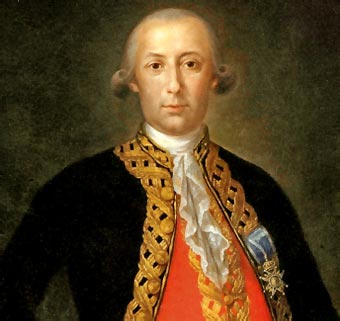Bernardo de Gálvez (1746-1786), a Spanish colonial administrator, was captain general of Louisiana during the American Revolutionary War. His heroic exploits against the British during the war won him fame both in Spain and in America.
Bernardo de Gálvez was born in Macharaviaya in the province of Malaga on July 23, 1746. Though poor, the Gálvez family belonged to the Spanish nobility, and young Gálvez was able to pursue an active and successful military career. At the outbreak of the American Revolution, Gálvez was assigned the post of commandant of the Spanish troops stationed in Louisiana, with the rank of colonel. He soon became governor and intendant of that Spanish province, assuming office in February 1777. Two years later the Revolutionary War became a world struggle as Spain joined its forces with those of France in the battle against Great Britain. Spain refused to ally itself directly with the United States or to recognize American independence because of its own position as a colonial power. Nevertheless Spain supplied the Americans with secret aid and undertook a vigorous military campaign of its own in America under the leadership of Gálvez.
Even before Spain came into the war, Gálvez had been actively engaged in providing arms to the Americans in the Louisiana area. On Spanish entry into the war, however, Gálvez took direct action against the British, and in three brilliant campaigns drove them out of West Florida, thus securing control of the mouth of the Mississippi River and the Gulf of Mexico for Spain. Of all his exploits in this period, the most famous was his daring conquest of Pensacola, in Florida, in May 1781. At the end of the war he returned to Spain to receive a hero’s welcome; promotion to the rank of major general; appointment as captain general of Louisiana, East and West Florida, and Cuba; and elevation to the viceroyalty of New Spain.
In 1784 Gálvez went back to America, where he acted as principal adviser to Diego de Gardoqui in preliminary negotiations with the new United States over the Florida boundary question, a treaty of commerce, and the right of Americans to free navigation of the Mississippi River; it was these negotiations that led to the Jay-Gardoqui treaty in 1786. In 1785 Gálvez was responsible for ousting from Natchez, in Mississippi, the Georgia commissioners who had come to establish Bourbon County. That same year, however, he won the thanks of the American government for his part in releasing American merchants being held at Havana. Gálvez died in Mexico on November 30, 1786.
PENSACOLA, FLORIDA. 9 May 1781.
Captured by the Spanish. The unhealthful British outpost and seat of the British government of West Florida was threatened by Louisiana Governor Bernardo de Gálvez in March 1780, when Mobile was captured. Pensacola’s strong defenses convinced Gálvez that he needed a larger force for the attack, and he went to Havana to organize the expedition. However, a hurricane scattered his fleet in October, and it was not until the following February that he was able to sail for Florida. Meanwhile, Governor Sir John Dalling of Jamaica, who was responsible for Pensacola, wanted to reinforce that base with a regiment of American Loyalists but was unable to get the necessary naval escort.
The British garrison at Pensacola was commanded by General John Campbell and counted nine hundred regulars, primarily of the Sixteenth Foot and Sixtieth Regiments, the latter composed largely of Germans, and two battalions of provincial infantry from Maryland and Pennsylvania. The fortifications bristled with cannon. When the Spanish naval commanders saw these cannon in early March, they refused to enter the bay. Not so easily intimidated, Gálvez took command of the brig Galveztown and led his colonial troops aboard a flotilla of smaller craft to land near the British fort. Shamed, the rest of the Spanish navy followed, landing several thousand troops. A rather leisurely siege ensued. It was not until the end of April that the Spanish began firing in earnest upon the British positions. On 8 May one of their shells landed on the fort’s principal magazine, setting off an explosion that killed or wounded nearly one hundred of Campbell’s men and demolished one of redoubts in the process. The Spanish attacked and were being beaten off by the British the first time. But the Spanish then seized part of the fort’s walls and set up cannon with which they could fire down into the garrison. Campbell capitulated the next day. West Florida was now in Spanish hands. Gálvez was rewarded with promotion to lieutenant general and ennobled by Carlos III.
Further Reading The standard account of Gálvez’s career remains Alce’e Fortier, A History of Louisiana, vol. 2 (1904). See also John Walton Caughey, Bernardo de Gálvez in Louisiana, 1776-1783 (1934).
